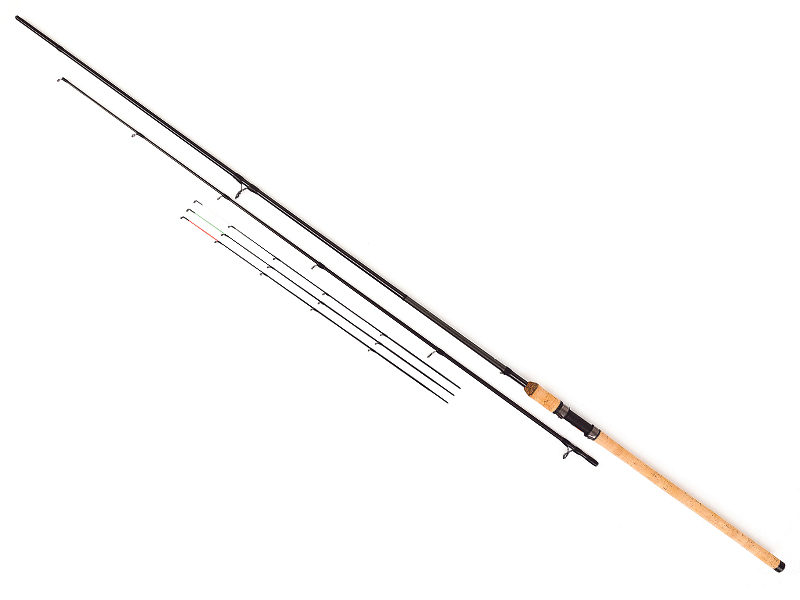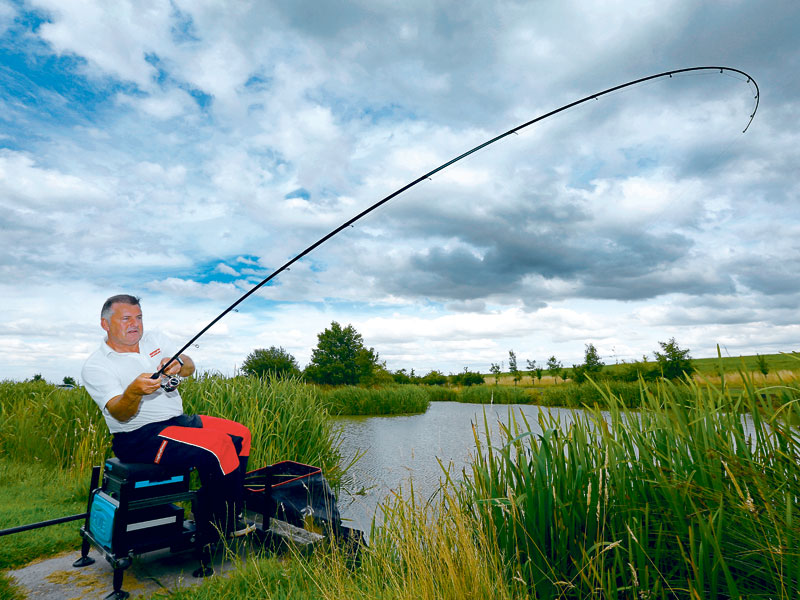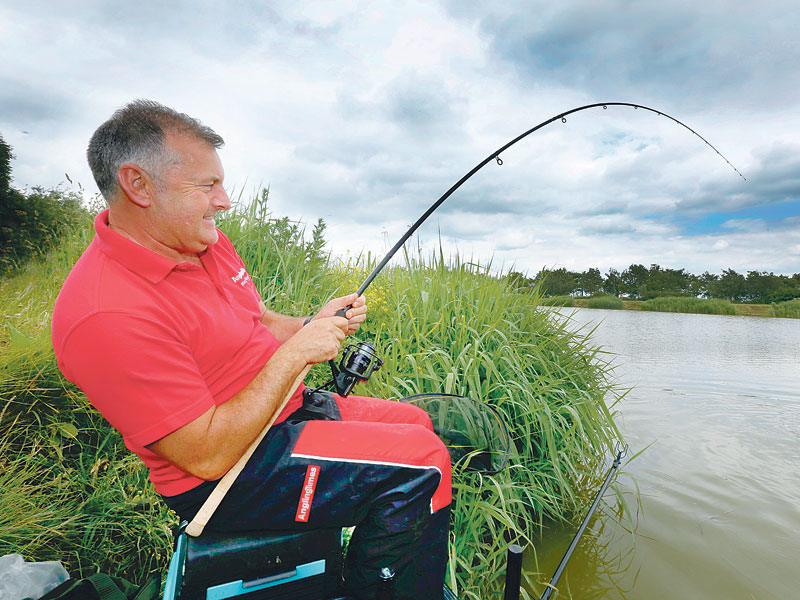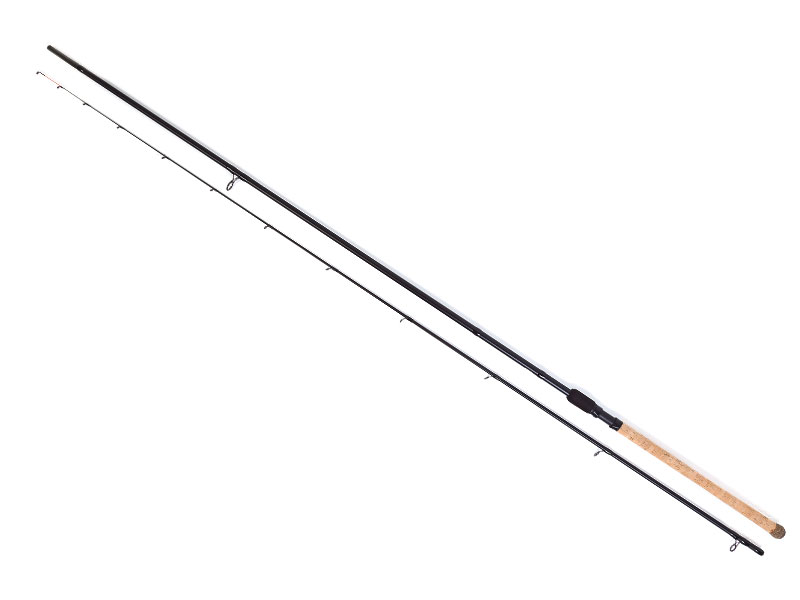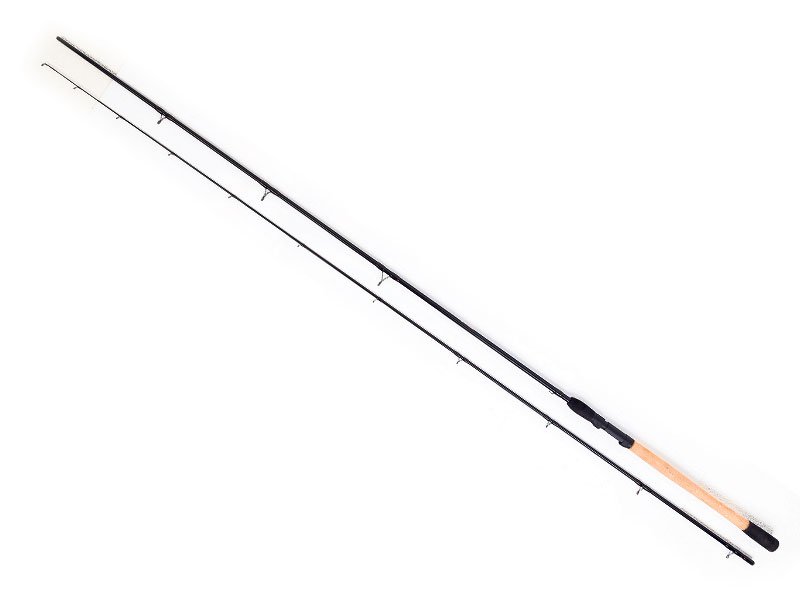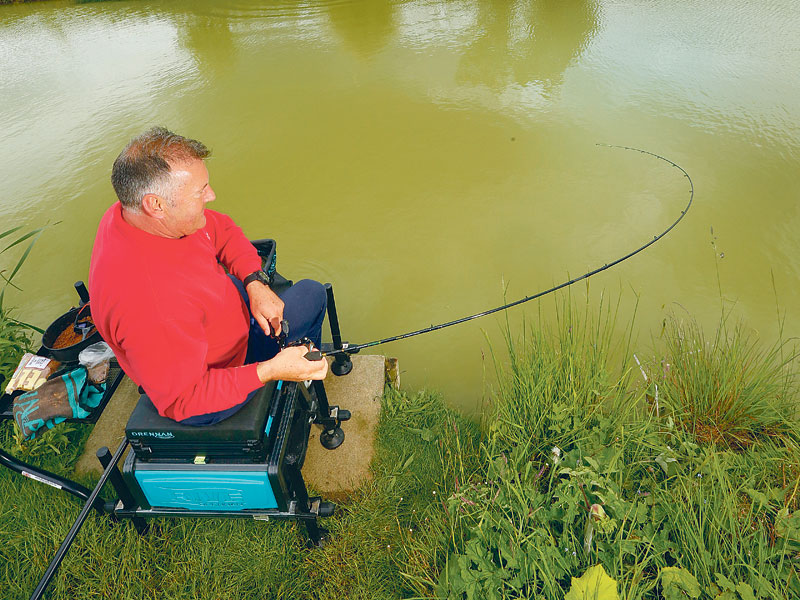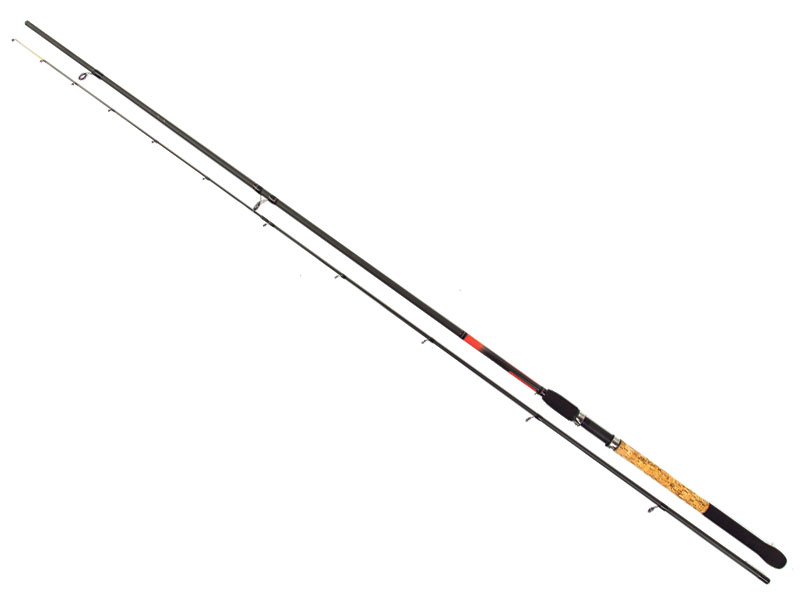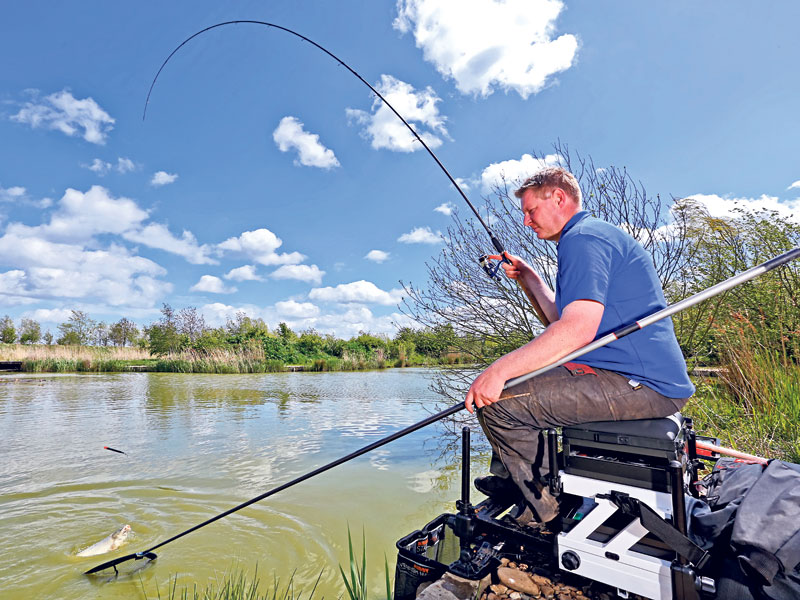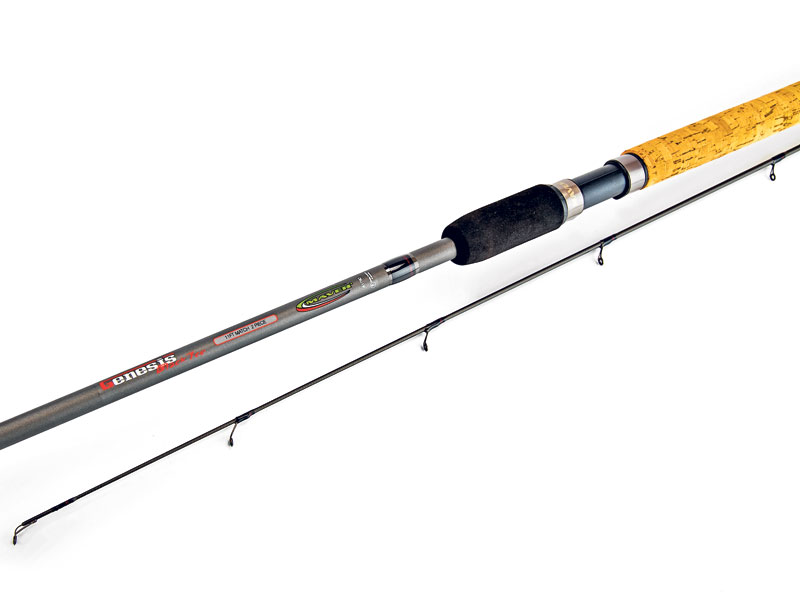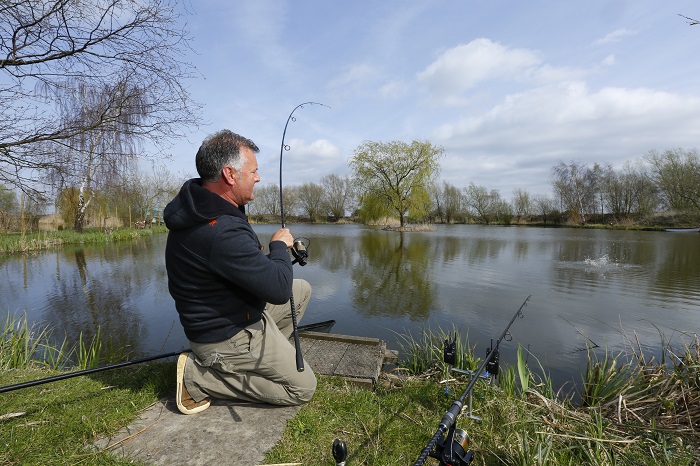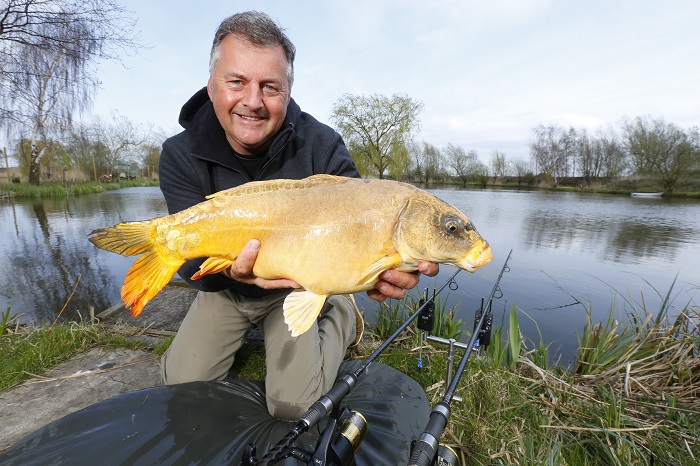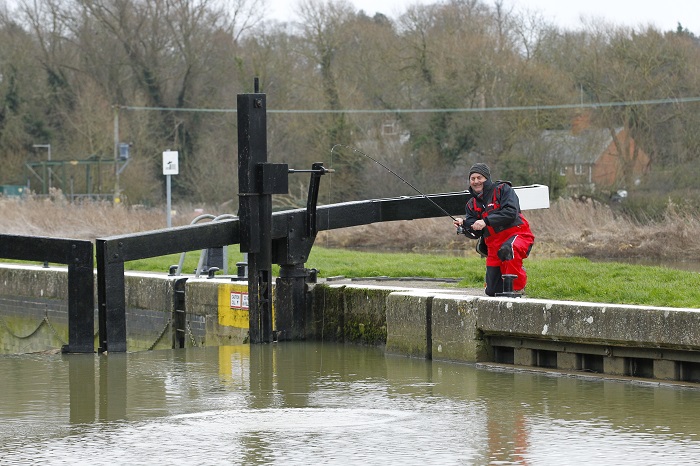Middy Nano-Core XZ65 World Elite 10ft Feeder rod
TECH SPEC
- Three special blank graded carbon push-in quivertips of 0.5oz, 1oz and 1.5oz test curves ensure a flat spot-free action, and make the rod suitable for a multitude of feeder applications.
- The rod comes with an original Middy aluminium hooded reel seat ideal for most reel sizes.
- The super-slim 20ins full cork handle makes the rod comfy to hold even when it’s under stress.
PAY AROUND
£209.99
Middy produces some mighty impressive commercial fishery rods these days – everything from short snake lake models to horizon-hitting beasts.
What’s more, there’s something to suit everyone’s pocket.
At the very pinnacle of Middy’s feeder rod range sits the new 10ft Nano-Core XZ65 World Elite, yours for a jaw-dropping £293.99. But panic not, as it can be found at a more realistic price if you shop around.
That said, it’s still a lot to lay out by anyone’s standards, so what exactly would you be shelling out for?
Well, for starters you get an ultra-slim (just 11mm at the butt section), ridiculously light, two-sectioned carbon fibre blank, the result of the very latest Nano-Core technology. This translates into a rod with lightning-fast reflexes, immense strength and flexibility.
The blank has undergone a unique high-pressure vacuum curing process that forces out any tiny air bubbles, ensuring a consistent performance and a flawless finish.
Other luxury touches include three push-in carbon quivertips rated at 0.5oz, 1oz and 1.5oz, seven ceramic-lined double and single SiC Ultra-Flow guides, and a thin full cork handle furnished with a screw-down reel seat.
Middys claims the rod will cast bombs and feeders up to 50g with mainlines up to 12lb and hooklengths up to 8lb.
So far that’s pretty much standard manufacturers’ marketing speak for a commercial feeder rod of this ilk. But in my humble opinion top-end or flagship models should always have that bit extra, the ‘wow factor’ if you will...
You’re already paying for the classy furnishings, fittings and carbon technology, but without that noticeable edge to the rod’s performance all that counts for nowt – and that applies to all tackle brands, not just Middy.
And so to the live test. A favourite water of mine is the peaceful day-ticket Stretton Lakes, just off the A1 north of Peterborough. The fish here are of an average size, and respond to most open-water tactics – ideal helpmates for tackle testing.
Assembling the rod, you cannot help but be impressed by its pencil-slimness – in fact I found the full cork handle a tad too skinny for my own assortment of butt rests, and would suggest that any prospective buyer should look for a small U-bend abbreviated rear rest of the sort favoured by carp anglers.
The sections are not quite equal in length when the carrier section has a quivertip in place, so you need to be extra careful when you’re putting it away ready made-up, even though the classy Middy padded carry bag is more than long enough for the job.
I was not wholly convinced by its suggested 50g maximum casting weight. For me, the top end of the carrier section has a little too much play, and while there is no denying its impressive post-cast recovery speed, this rod is clearly not of the ‘give it a whack’ breed – face it, if you miscast and take out the top section that’s a very expensive mistake to make.
And there end my criticisms. The fact is, the performance of the 10ft World Elite will have you purring with satisfaction. It has a wondrous amount of torque and feel, with a handling aptitude right up there with the very best.
The immaculate gunmetal grey blank has a phenomenal pick-up speed, and its responsiveness to any size of hooked fish actually takes a bit of getting used to. It’s a bit like stepping straight out of your old family saloon and into a works rally car, but once you adapt to the change it’s all systems go – only you won’t have to strap yourself in!
VERDICT
A genuine high-performance rod for the commercial fishery connoisseur, this top-end Middy model will handle most weights of flatbed feeders and straight leads up to 40g (1.5oz). It is equally at home using a maggot feeder with light lines and small hooks for F1s as it would be targeting much bigger fish with bread discs in winter.
Mark Sawyer
Daiwa Harrier Match Pellet Waggler 11ft
TECH SPEC
Full cork handle
Eva down locking fore grip
Matt low glare finish
Light balanced blank
Medium fast actions
PAY AROUND
£49.99
What could possibly prove to be as popular as Daiwa’s TDR and Yank N Bank rods?
Strong contenders must be the 10ft, 11ft (on test) and 12ft Pellet Waggler rods in the new and very affordable Harrier range.
All eight models are realistically priced to put them within reach of anyone wanting to own a Daiwa rod but not blessed with infinitely deep pockets.
That doesn’t mean that the blanks used in their production are in any way inferior, or have cheap fittings. In fact, judging by the test sample sent in to me at Angling Times it’s as though the company has taken extra care to ensure that these bargain-priced models meet Daiwa’s usual high standards.
They all boast a low-glare matt finish which gives them a nice hand-built look, the full cork handles have reliable locking EVA foregrips, and along the blanks are correctly positioned double and then single-leg lined guides which contribute to a medium-fast, progressive action with no flat spots.
Okay, I wouldn’t bet on them being made from the finest high modulus carbon fibre cloths, but these graphite-built beauties feel light and well balanced, with no wobble and a crisp post-cast recovery.
However good a rod may look, the acid test is how well it performs, and a few hours spent throwing around a variety of pellet waggler and splasher floats confirmed the 11ft Harrier Pellet Waggler’s suitability as a cracking small to medium-sized commercial fishery tool.
It is more than comfortable handling floats from 4g up to 10g and reel lines from 6lb-8lb but it’s – let’s say – just a little too ‘manly’ for anything much lighter in the float department.
The fast tapering two-piece blank generates a surprising amount of power, certainly considerably more than I had seen up until now from a graphite-built rod. It’s not overly pokey, it doesn’t feel in the least like a broom handle, but it’s quite a muscular caster. Don’t be afraid to give it a fair old overhead whack to punch out a float against a headwind.
Fish are dealt with quickly and efficiently too, something I found particularly useful when needing to guide lively 3lb-5lb carp around the tackle-wrecking thick reed beds surrounding Sallow Lake on the day-ticket Homeclose Fishery in Rutland.
If you regularly visit a snaggy venue holding big carp that respond well to float tactics, this could be just the rod you’ve been looking for.
It’s built to take the odd knock and bounce back unscathed, and at a penny under 50 quid it really is a steal.
VERDICT
Daiwa has dressed this rod to look like one costing three times the price. Well suited to bigger commercial fisheries, the blank delivers ample fish-playing power and casting clout, but its carefully crafted carbon and glass construction and fast tapering design prevents it from being overly aggressive.
Mark Sawyer
Free Spirit Surface Creeper 'E' 11ft rod
TECH SPEC
- Perdurable blank finish
- 40T carbon weave
- Free Spirit machine-cut aluminium reel seat ion-plated with a blue-grey finish and with a milled isotope slot available as a build option - please enquire
- S-Lite 3-leg rings
- Fuji DPS reel fitting
- Full EVA handle
- Ring sizes (mm): 30 to 8
- Custom build options
- S-Lite tip ring designed to minimise the chance of tangles (and crack-offs) on the cast.
- The Fuji DPS 18 reel seat is light, ergonomic and totally secure – reel seats don’t get much better than this.
- The test rod came with a full EVA handle, but there are cork and shrink tube options available as well.
PAY AROUND
£109.99
Disappointing summer fishing weather is as British an institution as mother-in-law jokes – and has about as much grounding in fact.
More typically, the sun will put his hat on – and that’s when big carp show an interest in floating baits.
Surface fishing can be thrilling yet frustrating as every single bait (except the one with your hook in it) slips silently under the surface, seemingly drawn inexorably downwards by an unseen magnet.
Tricky and nerve-tingling, fishing with floating baits is stalking at its most primeval level – man pitting his wits against crafty fish that have seen it all before. It can drive you half mad. “Why won’t they take my bait?” you ask a passing moorhen as you strike far too late at yet another half-chance.
But when it all goes right, as it did when I live-tested the two-piece 11ft Free Spirit Surface Creeper ‘E’ on Mitre Pool at Bishops Bowl fishery in Warwickshire, all the earlier frustrations are quickly forgotten.
This specialist floater tool has a soft, sensitive tip suited to small controllers and light nylon hooklengths. It is also more than handy for margin stalking and freelining.
The classy chequered 40 tonne Perdurable (non-scratch) all-carbon blank is typical of the aspirational Free Spirit brand. With understated white graphics on the butt section, a Fuji DPS 18 reel seat and braid-friendly S-Lite guides throughout (starting with a 30mm butt guide), the rod on test had a full EVA handle, although full cork or full shrink tube options are available for a small additional charge.
In action, the Surface Creeper ‘E’ takes the biscuit – as indeed do the carp it snares. No, it doesn’t have the casting clout to belt out a weighty controller 100 yards, but it wasn’t built to do so. However, it will cast smaller floats up to 20g well over 50 yards with ease, making it an ideal choice for medium-sized lakes and pits. Its tippy action will flick out a freelined mixer a fair old way, as long as you’re using light reel line.
The live test went well, and the rod’s L plates were off in no time at all.
Feeding some freebies, then hiding away behind some reeds, gave the carp confidence, and soon one made the error of slurping down a mixer with a hook attached. Quick as you like the Surface Creeper took on its full fighting curve, best described as all-through but with steel running through the mid-section. This gives the soft-tipped blank enough poke to deal with hefty lumps without it feeling overgunned.
Soon a scale-perfectmid-double mirror was laid on the unhooking mat… don’t you just love it when a plan comes together!
VERDICT
What a month for live testing fishing rods it’s been! First came Browning’s awesome new 12ft Sphere Feeder, the ultimate bream rod. Then it was the 11ft Free Spirit, perfect for surface fishing with its soft, forgiving tip that allows it to be used for freelining mixers or controller work. It’s ideal for all but the very largest open-water venues.
Mark Sawyer
Browning Sphere Feeder M 3.90m rod
PAY AROUND
£249.95-£399.95
Browning’s new Sphere rods are aptly described by the European tackle giant as being ‘from a different world’.
Made from the very highest quality carbons, every aspect of their design is engineered to produce a finished product that is as near perfect as it can be.
The Sphere blanks are said to be the slimmest and lightest high-modulus carbon rods available, and features include superb ultra-low-friction ‘skeleton’ SiC guides throughout, plus an ergonomic, weight-reducing handle which transmits more ‘feel’ through to the angler.
Between them the seven Sphere Feeder models cover every possible aspect of feeder fishing, from lightweight two-piece silverfish models through to 4.2m (13ft) firm-actioned rods capable of handling heavy leads in raging torrents.
Browning claims the rods will add yards to your cast, yet remain responsive enough to safely play soft-mouthed fish like skimmers and withstand the thumping head-shakes of really big bream without fear of hook-pulls.
That is quite some claim. I have seen and used many really good bream rods in my time, but nothing has ever been absolutely perfect – until now, that is!
From the moment I first handled these rods in Browning’s German factory I knew they were a bit special. The first clue to their excellence came during a conversation I had with Bob Nudd at this year’s Big One show. Bob excitedly handed me one, proclaiming: “This is the best feeder rod I have ever seen.” Praise indeed from a five-time World Champ with a lifetime of match and festival wins.
Recent sellout match attendances at open-water bream venues such as Peterborough’s Ferry Meadows had brought me a spate of ‘which rod?’ emails. These, along with questions from anglers on the bank asking about distance feeder rods, were all the excuse I needed to ask Browning to send in a Sphere for review.
This they duly did, and I received a 3.90m (12ft) three-piece Feeder M that I was assured would be ideal for long casting to big bream in open water.
Now, let’s clear one thing up, these rods are eye-wateringly expensive, with prices from £249.99 right up to £399.99, so you would expect them to be more than reasonable. However, they do come with four matching push-in tips which offer the ultimate in bite detection.
Settling into permanent peg 127 on Ferry Meadows’ Overton Lake, it was time to get some bait in. Clipped up at a modest 60 turns on the 4000-sized reel, the rod delivered a fully loaded 30g feeder bang on to the spot every time. Even a niggling headwind did nothing to affect accuracy or distance.
After 20 minutes of constant casting to get some feed out, I unclipped the reel, tied on a heavier feeder and unleashed the beast – ‘awesome’ is the only the word that does this rod justice.
The power kicked in through the middle section, the carrier was virtually recoil-less, and 90 turns later the feeder was back in my hand. Now I wouldn’t claim to be the best caster around, probably only just better than average. But never before had I chucked a feeder so far with so little effort.
But would this rod prove too stiff to play a big bream on? We’ve all been there – up pops the feeder, the bream starts shaking its head, and the rod doesn’t cushion the weight of the feeder being tossed around, so out comes the hook.
It’s the saddest sight in match fishing, staring at an empty landing net head with a big swirl behind it.
Suffice to say, this rod handled the situation with consummate ease – every fish was brought to the net early, apparently increasing the likelihood of a hook-pull, but everything stuck fast.
I could go on and on about the virtues of this rod, but I’ll leave you with this thought… don’t buy any other distance feeder rod until you have seen a Sphere.
VERDICT
Without doubt these Spheres are the best rods Browning has ever produced. Casting with breathtaking performance and accuracy, they have unequalled fish-playing powers, and are aesthetically unlike any others. If the rest of the Sphere Feeder series is anywhere near as good as this 12ft medium test model than Browning has created something out of this world.
Mark Sawyer
Matrix Method Master 11ft Feeder rod
TECH SPEC
In this range, there is a choice of 9ft, 10ft, or 11ft, all with casting weights of 20gms to 50gms.
• High modulus carbon blank.
• Semi-parabolic fish-playing action.
• Designed for up to 25m.
• Casting weight: 20gms - 50gms.
• Ideal for fishing the method on the pole line of on snake type lakes.
• Short handle for easy manouvering when casting and playing fish.
• Lightweight, strong double and single leg guides positioned for easy made-up transportation.
• Cork/EVA handle with soft-touch screw down hood reel seat.
• EVA transport holder block holds all sections parallel for easy made-up transport.
• Ideal for all method feeder\pellet feeder fishing.
• Rods break down into two equal lengths.
• Supplied with two (3/4oz, 1oz) interchangeable tips.
• Line rating 4lb - 8lb.
PAY AROUND
9ft £59.99, 10ft £64.99, 11ft £69.99
Matrix has added three new Method Master feeder rods to its range designed to tackle commercial fisheries.
In 9ft, 10ft or 11ft lengths, all three blanks will cast Method feeders weighing between 20g and 50g (0.7oz and 1.7oz), which will cover nine out of 10 pools you’re likely to find yourself pegged on.
At a time when quality short feeder rods can set you back a considerable chunk of wedgeit’s quite refreshing to find that these superbly appointed rods can be had at under £70 a chuck.
So, what’s the catch – if indeed there is one? To find out, and hopefully make a decent catch of my own, I settled into a peg fringed with Norfolk reed on the day-ticket Kingsland Reservoir, just outside Peterborough, equipped with the 11ft version of the Matrix Method Master.
The fish in this deep lake – mainly carp – show a definite taste for baits presented on the Method, especially close in to the margins. This tactic obviously doesn’t test a rod’s casting attributes, but it does put its fish-playing mettle under the spotlight.
Before you even wet a line, one of the first things you will notice when putting together the two equal-length sections of this 11ft blank is its fast taper from butt to tip.
This gives it a high weight loading area toward the tip end of the carrier section and enables the rod to hold pretty much rock-steady before casting.
There’s none of that bouncing around of the feeder that can be such a pain in the butt section – yours!
This lack of movement improves the rod’s distance casting and accuracy, and after half-an-hour of trying out different weights of feeder I can happily report that it will handle 30g flatbed models with very little effort. That said, I felt that the manufacturer’s recommended maximum casting weight of 50g would be overstretching the rod.
No matter, the plus points way outstrip this small negative. The blank is a composite of carbon, glass and resins which together produce a rod lacking in flat spots, and with enough backbone and grunt to tame the odd Barney Rubble.
This rod is immensely enjoyable to use. Bend it like Beckham and it will put fish in the net time and time again.
Indeed, if you’re into your commercial match fishing, it should help you score a good few points over the opposition.
VERDICT
The new Matrix Method Master casts accurately and sufficiently far to cope with the majority of commercial fisheries. The equal length two-piece blank has lots of feel and transmission, and its controlled progressive bend will cope with fish big and small.
This very affordable rod can be used with reel lines between 3lb and 8lb, and is destined to become a firm favourite with all club match anglers on a budget.
Mark Sawyer
Preston Innovations 12ft Pellet Waggler rod
PAY AROUND
£169.99
This 12ft Pellet Waggler rod is the latest addition to the best-selling Carbonactive Mini Plus commercial range from Preston Innovations.
Honed to perfection for casting splasher-type floats and big pellet wagglers on open-water venues such as Viaduct, Barston and Meadowlands, this rod was developed with input from talented match angler Andy Power.
Andy can list wins in the Maver Match This and UK Champs, as well as qualifying for three Fish O’Mania finals, in a long line of achievements.
In a chat I had with Preston’s brand manager Scott Geens about the ins and outs of the blank’s construction, he told me that Andy had netted fish to over 20lb from Viaduct during its field trials, so no worries on that score!
I was lucky enough to be given an exclusive preview of the new Preston tool, and I never pass up the chance of chucking a big pellet waggler around – besides, the sun was shining.
So I found myself pulling up in the car park of the Canal and River Trust’s day-ticket Engine Pool on the Earlswood complex, armed with little more than a few bags of 8mm pellets for bait and feed, and a box of distance-casting wagglers.
Engine regulars will know just how fickle this water can be. It’s very much feats or famine, but with rock-solid information that the pegs in the high 70s were rammed with fish, my confidence of nailing some proper lumps was riding high.
It was less buoyant after three-and-a-half hours of constant casting and feeding, feeding and casting, swapping between wagglers of the splasher, pellet, clear, loaded and unloaded kind, even some with popper discs.
Having gone through every permutation of floatfishing up in the water, all I had to showfor my endeavours was sore knuckles from what must have been a thousand raps from the pouch of my catty.
You could say my interest was flagging somewhat.
My photographer, Lloyd, had taken to doing ‘wildlife’ snaps – well, that’s what he called them, but I never realised that insects wore Lycra shorts and went jogging round lakes!
With time pushing on, what had I learnt? Well, the Preston 12ft Pellet Waggler rod has quite a fine tip for what is basically an animal tamer.
It will cast just about anything you care to tie on to the reel line, bar possibly a bagging waggler – anything else isn’t a problem.
Even the largest vaned pellet waggler from John Bonny (the Mad Hatter of float makers) can be cast completely out of sight.
I had matched the rod with a 6lb reel line – with 8lb your casting distances would suffer as the guides are all of standard match size to handle thinner diameter lines better. I’d recommend you to play your cards right and stick to 6lb line, not going higher or lower.
Then it happened. The float landed with an angel’s caress, to be greeted with a swirl as an Engine Pool brute couldn’t resist what was obviously my above-standard banded pellet presentation – or perhaps it was down to the fact that it was now getting dark. It matters not – the blank swept the line up in a none too sloppy manner from the surface, then kicked into its progressive fish-playing action.
Now I could finally see the benefits of all that field-trialling. Yes, the rod has unbridled power, but it’s all been channelled into the blank’s middle section. When you lean into a fish it absorbs then dictates… you know you’re in charge.
It’s a strange thing with carp that sometimes, if they feel they are on the losing side from the start, they all but give up. Right at the net, the Earlswood projectile made a half-hearted bid for the legs of the platform, but a smart side swipe from the rod brought it straight up on top and into the pan.
How good is that?
VERDICT
This classy rod from the Preston Mini Plus stable has plenty of brutish power tempered by just the right amount of finesse, and the build and finish are both top-notch.
It’s quite capable of dealing with the largest of fish, but it’s fun to use and sure to become a favourite with anglers visiting big open-water venues this summer.
Mark Sawyer
Browning Commercial King 8ft F1 Wand
TECH SPEC
Length: 8’/2.45m
Sections: 2 + 3 Tips
Casting weight: 2 – 4 lbs
Travel length: 1.27m
Weight: 150g
PAY AROUND
£59.99 both models
If you feeder fish snake lakes that don’t require massive casts then this wicked little rod should have your name on it. And here’s why…
Browning has further improved and refined its Commercial King Rod range to include these two gossamer 8ft Carp and F1 Wands, both of which eradicate hook-pulls while having the capability to land any big bonus fish.
The pencil-slim, through-actioned blanks bend all the way from their tips through to their cork handles. The F1 model, on live test duty, has the more forgiving action and is rated at around 20 per cent softer than the slightly beefier Carp Wand.
I favour short rods with actions like this because they can transmit every flick and flutter from fighting fish of all sizes, yet effortlessly cushion the most fragile hooklengths and tiny hooks.
They allow an angler to present really light rigs to finesse bites from shy-biting winter F1s and skimmers that have seen it all before, and they more than justify the asking price for use on hard winter commercials, where you might be fishing for just half-a-dozen bites in a match. Their reduced length allows you to easily tuck them out of harm’s way down the side of a platform, well out of the wind.
The F1 Wand is built to fish with reel lines of 2lb-5lb, while the Carp model can handle slightly heavier mono from 3lb-8lb, with appropriate hooklengths, but I wouldn’t go much below 0.10mm even with the F1 version.
I paired my test rod with a 4lb mainline that blended sweetly with the two-piece, 8ft blank. Three fine glass quivertips of 0.5oz, 1oz and 1.5oz come with each rod. These will register delicate bites while still managing to accurately throw feeders and bombs of up to 2oz. Reduced length rods are reckoned to give much greater accuracy over long ones when making the short-range casts required on many commercials these days. They’re also definitely easier to use in tight swims hemmed in by vegetation.
I took the test rod to the prolific Greensands snake lakes fishery near Sandy, in Bedfordshire, to fish a small 15g flatbed feeder loaded with dampened 2mm pellets and fine fishmeal goundbait with a 6mm hair-rigged banded pellet and size 16 hook.
The first thing you notice is how light the Browning Commercial King F1 Wand feels. The next is how easy it is to cast overhead, plopping the feeder accurately hard up against the far bank, or features such as islands or aerators, at distances from just beyond pole range to around 30 yards. On many day-ticket venuesbeing as little as 12ins off target makes all the difference between a good day and an average one.
No worries – it’s my bet that with this pint-sized belter sitting on your rod rest, you’ll be bang on the money every chuck.
VERDICT
This super pair of 8ft Wands from the Browning stable are ideal for commercial snake lakes and small pools. The F1 model, in particular, would be hard to better for this kind of fishing. It would make an exceptional winter maggot, feeder and small-hook F1 tool.
Mark Sawyer
Shakespeare Sigma 10ft Commercial Feeder Rod
The Shakespeare Sigma Commercial rod range features two-piece carbon blanks with powerful, but progressive, actions. These rods are designed to allow for accurate casting and making the playing of hard-fighting fish easier and faster.
THE RANGE
Sigma Commercial 11ft Float
Sigma Commercial 10ft Float
Sigma Commercial 11ft Feeder
Sigma Commercial 10ft Feeder
PAY AROUND
£39.99
Every match or pleasure angler who catches big fish on commercial pools should have a rod like this in their holdall.
Carrying a full recommended retail price of just £39.99 (although you’ll find it even cheaper if you shop around a bit), it’s eminently affordable.
With two equal-length sections, the 10ft rod is easy to carry ready rigged for action. Its composite carbon and glass construction generates a fast casting action, and it plays fish firmly yet forgivingly.
I was soon to experience its qualities at close range as I ran the rule over this Shakespeare 10ft Feeder, part of the famous firm’s new four-rod Sigma Commercial range.
The kind of venue I would choose for a feeder/lead rod of this type is a small to medium-sized commercial pool of between 20 and 40 pegs, with required casting distances of 15m-40m. The open-water strip lakes at fish-filled Decoy Lakes near Peterborough fit the bill perfectly, and so armed with some timely advice from Angling Times deputy editor Kevin Wilmot, I aimed for a peg at the top end of Oak Lake.
A few exploratory casts down the lake with different weights of feeder confirmed the casting credentials of the new Sigma, which are amazing for such a short rod. The fast tapering blank has a high weight loading point, matched with impressive poke from its butt section, and will cast feeders and straight leads of up to 40g more than 35 metres. This is more than enough for most commercials.
My casting target on the day was actually little more than 25m, enough to position a 15g flatbed Method feeder tight up against the only feature in the lake, a paddle-type aerator. Pinpoint accuracy was needed, and the sparky little Sigma didn’t disappoint.
The blank is recommended for use with reel lines up to 8lb – quite heavy, in other words – and hooklengths from 0.12mm upwards.
The rod’s most outstanding asset, though, has to be its splendid progressive action. Far from being wetter than a haddock’s bathing costume, it manages to blend a soft tip with a fast-tapering mid-section, which makes the playing of big fish quick and easy, never stiff or overpowering.
My first fish of the day proved the point when the quivertip (two graded carbon tips of 1.5oz and 2oz are supplied) slammed round hard as a big kipper made off with my double corn hookbait. The rod did its job nicely, absorbing every lunge and run all the way to the net.
This is normally when most big fishtend to come off the hook, but not this time! The blank kept the fish under close arrest without any worries that it was about to slip the handcuffs and escape.
VERDICT
A very impressive rod from Shakespeare, and impossible to fault, given such a low asking price. It casts well, has a super power-playing progressive action, and could turn its cork handle to conquer most feeder and straight lead commercial fishery situations.
Mark Sawyer
Middy 4GS Micro Muscle Waggler Rod
TECH SPEC
- 11ft Super slim Supplex high-modulus carbon two-piece blank
- Soft-touch EVA thumb grip
- Ergonomic lock-down reel seat
- Hook retainer
- SIC Feather-Lite gunsmoke guides
- Max mainline 12lb
- Max hooklength 8lb
- Casting weight 25g
PAY AROUND
Price (RRP): £139
Shop-around price: £99.99
I take my hat off to Middy, and I’ll tell you why. Not that long ago, very few serious matchmen would have believed the Derbyshire firm capable of producing commercial fishery pellet waggler and float rods to the high standards they demanded.
However, that’s all water under the bridge. Since Middy introduced its original, superb and hugely successful X Flex 3G Pellet Waggler rod series the company has firmly established itself as a market leader for rods of that ilk.
The all new Middy 4GS offerings definitely continue the tradition, with several key improvements, including Supplex carbon technology.
This leads to a refined tip action, allowing fish to be landed even more quickly, as extra power is available through the butt section without risking hook-pulls or snapped hooklengths. Other improvements include an upgraded, progressive fish-playing action and better handling and balance.
All very impressive – but why would Middy need to make changes to a model that was voted rod of the year a couple of seasons back?
Any doubts along the lines of ‘has Middy mended something that clearly wasn’t broken in the first place?’ were all laid to rest as I spent a few hours putting the new 11ft 4GS Micro Muscle Waggler through its paces at Oakfield Fisheries’ day-ticket Red Kite lake.
The ultra-wary carp in here grow big, really big… which is handy, as the new Micro Muscle is rated more than capable of dealing with zoo creatures into double figures.
At first glance the ultra-slim and very lightweight 11ft blank didn’t look capable of dealing with an awful lot more than disorderly dace, rampant roach or badly behaved bleak. But, as they say, looks can be deceiving, and beneath the rod’s cold gunsmoke grey finish beats the heart of lion. Here we have a lean, mean, mauling, brawling battler – disguised as Clark Kent.
It has power to burn through its middle section, and just look at the main picture – have you ever seen a sweeter, more progressive fighting curve in a rod? Certainly not on one that can be found for just under a hundred quid, as this one can.
Another thing that had bothered me a bit about this rod also resolved itself during the live test. Why didn’t it get the obligatory ‘Pellet Waggler’ label? The answer was simple enough – and it was no oversight on Middy’s part. Basically, the softer tip allows it to be used with a much wider range of floats, and it will cast normal and pellet wagglers up to 25g.
Casting distance was pretty good too. With full compression, a maximum range of around 25m can be achieved. Middy gives it a mainline rating of up to 12lb, way too high in my opinion. You’ll get far more performance out of it with 6lb-8lb line.
Fittings are all top-notch, with a comfy lock-down reel seat on a cork and EVA handle, and quality matching gunsmoke grey SiC Feather-Lite lined guides. Ideal for all short to mid-range work on commercial fisheries, this rod is without a doubt another winner from the Middy stable.
VERDICT
THE 11ft Middy Micro is one of the finest rods released this year. Its almost elastic ‘never ending’ progressive fish playing action is right up there with the best I have used,
but at a price that belies this lofty accolade. If your mate owns one, and lets you have a go with it, it’s a given that you’ll have one in your holdall by the following weekend.
Mark Sawyer
Maver Genesis Black Ice 11ft Match rod
• EVA twist grip
• High quality lined guides throughout
• Quality graphite screw reel fitting
• Folding hook keeper ring
• Action: Tip; Through action
• Casting Weight: 60g-90g
• Line Rating: 3lb-8lb
• Weight: 185g inc tips
• Featuring the stunning ‘Black Ice’ carbon finish and top quality fittings throughout. Supplied with three carefully graded tips.
Sometimes tackle can suffer from being labelled ‘one method and one method alone’. Margin poles are one example.
Pellet waggler rods are another, leading the customer into thinking that they can only be used for very specific tactics. The truth is often very different.
Match rods are a case in point. The tag may evoke images of stick float fishing on rivers with 2lb hooklengths, but with modern design, materials and build techniques your standard match tool can actually achieve a great many things. Maver’s Genesis Black Ice 11ft Match rod falls nicely into that category.
Don’t let the ‘Match’ part of its name put you off – this rod has been designed for pellet waggler fishing on well-stocked commercial waters, but its action and softness make it perfect for a spot of roach bashing on lakes and rivers too. It’s the ideal all-rounder for the angler who may only be able to afford or want one rod in their rod bag.
Made from high modulus carbon, the two-piece Black Ice packs a lovely through action, with ample softness in the tip to allow you to fish with light lines when needed.
However, Maver had both eyes on carp when building this rod, and it’s when you gear it up with a 6lb mainline and a loaded pellet waggler that the Black Ice really comes to life.
Soft it may be, but it’s not so sloppy that your casting will be all over the place. There’s enough poke to pick up line to hit fast bites, and more than enough guts to land big fish.
It’s also very light, weighing just 185g, so you can fish with it in your hand all day with no fatigue at all.
Testing took place on Magpie Lake at the up-and-coming Rookery Waters in Cambridgeshire, chucking a loaded 8g waggler to a bed of lily pads at around 40 yards.
Despite a brisk Fenland cross wind, the control that the Black Ice gives you on the cast sees the float landing time after time in the right place, essential when you’re building up a swim.
Landing the float is only part of the battle, though – some rods can fall down on the strike. Too sloppy an action and you simply can’t pick up the line in time, but the Black Ice is deceptively good at doing this.
Even with a bit of a bow in the line, a forceful strike made short work of those lighting bites that often come just as the waggler settles.
There’s also enough grunt to get carp away from snags quickly when you need to ‘hit and hold’ as soon as the hook is set. Get a fish within netting range, though, and the rod takes on a very soft action, bending right the way through the blank at times but never leaving you with the feeling that you’re in any way undergunned!
Finished with top-quality SiC guides, graphite screw reel fitting, EVA twist grip and folding hook keeper ring, the Maver Black Ice is the ideal rod to carry made up in a rod sleeve, all ready to take on whatever your summer of fishing is about to throw at you!
Richard Grange
Free Spirit CTX Carp Rods
PAY AROUND
£99.99-£139.99
Those of you who already know their Tempests from their Titans and their Delkims from their Microns should also be familiar with the company Free Spirit and its Hi S Carp rods.
These have been star products for many years – hardly surprising considering that Free Spirit boss Simeon Bond, as well as being a top carper in his own right, boasts more than 25 years of rod-building experience.
Just a few months ago his brand launched its, let’s say, slightly more affordable CTX range of rods, and these have gone on to become arguably the fastest-selling specimen rods around, finding favour with the budget-conscious big-carp angler.
The CTX series covers a dozen models in all, catering for just about every scenario, from small runs waters (as used for the live test) through to extreme-range casting venues, where the special S.U. models are called for.
With test curves starting at 2.5lb and progressing up to 3.5lb, with 12ft and 13ft models as well as matching Spod and Marker rods, there really is something for everyone.
Without going too deeply into the technical blurb, it’s safe to say that each rod is built to exacting specifications, using a complex manufacturing process that integrates two different tonnages of carbon cloth before an X-Wrap goes on for additional strength.
The process results in an extremely strong, ultra-light and slim blank, much as you would expect from a firm whose products are so much in demand.
The new CTX rods’ cosmetics and furnishings are impressive by anyone’s standards. Understated graphics are tastefully positioned on the non-scratchgunmetal Perdurable-finished blanks. Fitted as standard are original Fuji DPS reel seats incorporating stainless steel collars and 40mm and 50mm ‘S’-Lite butt guides. These lend a great modern yet classic chic to the range.
Looks are all very well, but these days carp rods needs to to walk the walk as well as talk the talk. With a huge upsurge in day-ticket runs waters, all carp rods these days are likely to catch lots of fish, and those with little or no fish-playing or casting clout ge found out double-quick!
Now, it just so happens that close to the Angling Times offices is a cracking little runs water called East Delph, just outside the Fenland town of Whittlesey. On this type of smaller fishery I focus on fishing fun and enjoyment, so I always choose a light test curve rod – in this instance it happened to be the 12ft, 2.75lb Free Spirit CTX. This type of rod should serve a multitude of uses, having just enough backbone to cast 2oz leads with small solid PVA bags and being ideal for all chods, margin work and middle-distance casting.
It should also have a very tactile and softly progressive fish-playing action, to make the playing of a big carp an unforgettable experience. This CTX 2.75lb rod did the lot at a canter. Okay, I know it’s more in vogue these days to use 3lb or even 3.25lb test curve carp rods, but believe me, this one not only has the build credentials to match its top-end Free Spirit Hi S stable-mates, but it offers a performance to rival that of most other rods in its class.
Fishery details: www.eastdelphlakes.com
Preston Innovations Carbonactive Mini Plus 11ft 6ins Method Feeder rod
PAY AROUND
£169.99
Preston Innovations has given its best- selling Carbonactive Mini-Plus rods a significant makeover and added this two-piece 11ft 6ins Method feeder tool to the range. Right from the start Mini-Plus rods were a hit with commercial match anglers, as the reduced-length blanks, with their trademark forgiving yet powerful action, were ideal for getting carp to the net very quickly.
Despite significant changes, all the new Preston Mini-Plus rods retain their non-locking action and trademark ‘iron fist in a velvet glove’ feel. However, they do appear to have been built around slightly faster tapering blanks. This, far from being a negative quality, gives them more casting speed at the tip when they are wound up, always a useful quality when going for extra distance.
Cosmetics and furnishings on the new rods have been upgraded too. The whippings on the glossy jet-black blanks now boast classy red trimmings, and depending on the model you get either single or double-legged low profile ceramic-lined guides.
The cork and EVA handle is fitted with a soft-touch reel seat which is not only pleasingly comfy to hold, but clamps the reel stem close to the blank. This is handy if, like, me you have short fingers. To round off the technicalities there’s a fold-down keeper ring, always nice to see.
So how did the Carbonactive Mini-Plus actually perform? After all, the two-piece 11ft 6ins blank is an unusual length for a Method feeder rod, which would more commonly be found in standard 12ft and power 13ft versions. Yes, even shorter method feeder rods are available, but these are really designed for fishing down the edge, not for distance casting.
A rare creature our test rod may be, but with the help of match aces Des Shipp and Tommy Pickering Prestons has come up with something that’s absolutely spot-on for commercials with islands and features at the 30m-60m mark.
That point was brought home to me when live-testing the model at Suffolk’s day-ticket Hinderclay fishery. Like so many others, this complex has centre islands on a couple of its lakes, and accurate 40m chucks to these are essential from the relevant pegs.
The Mini-Plus will cast a small 30g fully loaded feeder with little effort on the angler’s part, and I would suggest that at a push it could propel a large 45g Method feeder a fair distance. That said, don’t buy it if you are just looking for an out-and-out power casting tool, which it isn’t.
The blank has enough backbone to keep a straight cast, even if you need to lean into the cast in the teeth of a strong headwind, and the lack of tip recoil and bounce helps as you approach the casting distance limit.
I am fast becoming a fan of the longer-than-normal quivertips Preston is using these days on its feeder models, blending as they do into the blanks with no flat spots. The Mini-Plus comes with a glass tip rated at 2oz and a 2.5oz carbon tip. In truth, because bites are usually bold wrap-rounds as the fish hook themselves against the weight of the feeder, I reckon an even heavier 3oz tip would be useful, and contribute to longer casts.
That said, the softer glass tip does make the rod a little more flexible, should you want to use it for open-end feeder work for bream. Thanks to the blank’s forgiving action, it is well suited to this tactic.
Browning Quantum Specialist Magic Perch Rod
PAY AROUND
£47.99
A recent trip to the Browning factory near Hamburg left me staggered at the sheer choice and volume of drop shot tackle now available. We Brits look to be catching up fast on the Continentals in our understanding of this specialist lure fishing technique, and judging by the number of anglers I see jiggling soft plastics from canal towpaths, not to mention the amount of drop shotting kit in tackle shops, we should soon be a major force to be reckoned with.
But just what have those Germans got that we haven’t – other than footballers who can win penalty shootouts? On the drop shot front, quite a bit really – but the good news is, nearly all the kit is available at retailers with Browning accounts.
My rod and reel pairing for this live test is not only exceptionally pretty to look at, but highly affordable – and the combo does all that’s asked of it.
So, enter the Quantum Magic Perch. This two-piece carbon, epoxy-coated rod comes in 2.1m, 2.4m and 2.7m versions. My choice for canals would be its shortest incarnation, which rather handily happens to be this week’s live test model. Its graphics are top-notch – who could resist the realistic perch scale design along the butt section? More practically you can add braid-friendly SiC guides, full cork handle, low-profile concealed lockable reel seat and cut-away thumb and forefinger recess which put you directly in contact with the blank.
The rod, according to Quantum, is tailored more towards light spinning than drop shotting, which is reflected in its 3g-18g casting weight parameters. This means it has enough backbone to chuck a fairly large lure around, but this is very much a bespoke perch rod. To that end the blank has a fairly soft progressive action with a fair bit of give in the tip section.
A stiffer-tipped rod seems to help impart the required jagging movement that makes imitation baits wiggle, and this one has an awful lot going for it. Nicely light in the hand at just 134g, very easy to manoeuvre around obstacles thanks to its short length, its cork abbreviated handle is warm and comfy to hold, even on the coldest of days.
The best bit, though, is the price – at just £47.99 it’s a steal.
Preston Innovations Classic Series 11ft-13ft Feeder
PAY AROUND
£139.99
If you had to choose just one feeder rod to handle all legering situations, it’s my guess many would go for an 11-13ft configuration.
This versatile combination blank was, I believe, originally launched by Daiwa and made available in both medium and heavy versions, green or red whipping denoting the rod’s specification.
Since that time similar rods have been produced many times over, and not just by Daiwa – just about every tackle company includes an 11-13ft feeder as a ‘must have’ rod in their range.
The very latest to hit the market has just been introduced by Preston Innovations as part of its new three-model Carbonactive Classic Feeder series.
These versatile rods are intended for the seasoned angling journeyman and – dare I say it? – are almost old-school. Classic retro traits include fast tapering high-gloss jet black carbon blanks with matching 25ins extra-long push-in glass quivertips, full-length cork and EVA handle and, most importantly, a seamlessly soft, progressive action free frpm flat spots.
My original plan was to take the Preston Classic to a medium-sized mixed stock fishery and run it through its paces with open-end and Method feeders of varying weights, fished at different distances, using a variety of baits. This strategy would in turn hopefully attract fish of many species, proving the rod’s worth as an all-rounder.
That was until almost every sheet of water, from lake to puddle, froze absolutely solid. Obviously the rivers would still be a Plan B option, but the tea-stained raging torrent that passed for the idyllic meandering Thames around Oxford looked about as inviting as a cold bath in January.
And so to Plan C. What you need when everywhere else is iced up is an inland ocean, a vast sprawling open expanse of water that the wind ruffles enough to prevent the ice from forming.
There was a very good reason that the car park at Boddington Reservoir was devoid of angler’s cars for the first time in its history. It was so bloody cold that you’d have to jump start a reindeer. I’d also heard on the grapevine that bites here right now were rarer than a Ringer snap-off.
Still, needs must, and after setting the kit up in the early 70s, with freezing cold hands I threaded the line through the rod’s sturdy double legged ceramic lined guides. Rigs would need to be simple affairs, as open-end feeders were hardly likely to bring much action my way. Relying on small but heavy Method feeders and straight lead set-ups, I began the test.
With the rod set in its full ‘three section plus handle’ 13ft mode, Preston claims it is capable of casting Method feeders and is equally suited to heavy work in fast-flowing waters. I reckon it is more than capable of doing both reasonably well, but despite the fast-tapering blank it’s definitely not a long-range Method feeder tool. It’s all a little bit loose and languid for full-throttle distance work.
It is, however, ideal at its full length for all deep-water bream and skimmer fishing. With the dolly butt section – which houses a single guide and fits above the handle – removed, the blank takes on an altogether different feel and casting action.
At the 11ft length (11ft 2ins to be precise) it will easily cast weighty Method feeders and has a lot more casting aggression. The fast taper kicks in when the blank is fully compressed, and will propel any type of feeder a surprisingly long way for an 11ft rod. It certainly isn’t poker-stiff, so it’s still capable of coping with soft mouthed fish.
I also rather fancy this would make a super river rod, perfect for hooklengths down to 0.12mm, smaller hooks and any species of fish. This very much keeps it in the mould of the classic 11ft-13ft design.
Preston Innovations Carbonactive Mini Plus 8ft 6in Carp Feeder Rod
PAY AROUND
£129.99
Short rods have proved a huge hit with pleasure and match anglers targeting commercial fishery carp and F1s, especially when using straight lead and feeder tactics.
Not only does their reduced length promote casting accuracy, ideal when a hookbait may need to be delivered with pinpoint accuracy, the quivertip ends can be tucked out of harm’s way down the side of a platform, preventing them from bouncing around in the wind and making it easier to see shy bites.
There are many different makes, types, lengths and styles of these petite rods to choose from with all popular tackle manufacturers producing them in droves.
When faced with such a bewildering array it can be difficult to make the right choice but I would always opt for proven reliability, and this is where Preston Innovations Carbonactive Mini rods really stand out from the crowd.
The Telford-based company was among the first to make reduced length commercial fishery rods with the Carbonactive Mini series proving a huge success and quickly becoming the market leader.
This superb rod collection is now in its second generation, after Preston recently introduced its latest Mini Plus range, of which this 8ft 6in Carp Feeder is the shortest, rated to fish lines of 3lb-8lb and supplied with glassfibre push-in quivertips of 3/4oz and 1oz.
However, don’t think for one minute that this bantamweight tool couldn’t handle a tussle with a decent sized kipper, because the whispish pencil-thin, two-piece blank is more than capable of dishing out a fair amount of punishment, something I found out while live testing it at the ever popular Makin’s Phase Two Reptile Lake.
Like all commercial lakes in winter, the fish in Reptile shoal up and sit tight, often in the hardest areas of the lake to reach. But if you find them a good day is on the cards.
The winning tactic is easy enough; you simply need to drop a light bomb or tiny feeder, with a couple of maggots, single grain of corn, or punched bread on the hook, on top of the fish.
The trick is making your rig land with little more than a plop.
This is where really short rods like the Mini Plus Carp Feeder come to the fore, as once you have the distance marked, the casting accuracy they are capable of producing means you can hit exactly the same spot time after time.
Bites are normally slow pull-rounds, which on this particular model will seem exaggerated, mainly because of the thin and fast tapering profile. Strikes are rarely called for in this situation, as the fish are already hooked, the blank whipping the line from the water in the blink of an eye.
Once a fish is hooked the blank takes on a sharply progressive fighting curve, with the tip acting as a cushion and the rest of the top section soaking up all the pressure. The stopping power is delivered from the butt section and it produces enough grunt to quickly subdue the feistiest of fish.
Preston claims the rod is ideal for all snake lakes and small ponds, which undoubtedly it is, but I feel this is underplaying the rod, because for my money it has more than enough beef to cope with small-river chubbing sessions as well.
Matrix Horizon S Class 12ft Feeder
The three-piece Horizon S Class Feeder is a traditional tool for bream and skimmer fishing. The high gloss black blank has a softly progressive action, but with enough power in the lower butt section to achieve casts up to 60m. Large-diameter guides throughout (quivertips too) allow the use of shockleaders with no fear of the leader knot jamming into a guide and causing a crack-off.
PAY AROUND
£149.99
THIS rod owes many of its superb specifications to the fishing talent and knowledge of Matrix boss Ricky Teale, who has spent years match fishing for bream here in the UK and in Europe, where long-distance bream tactics are seen as the pinnacle of angling achievement.
The Horizons S rod’s middle and tip sections are both longer than you would find on a standard three-piece feeder model, helping it to deliver a seamlessly smooth progressive playing action while maximising tip speed when going for a really long cast. A short butt section with an extra-long spigot joint adds to its casting clout.
During the live test Angling Times editor Steve Fitzpatrick, not noted for his smooth distance-casting style, had a go with the set-up and was so shocked at the instant extra yards he attained that he wouldn’t give it back.
During the trial it handled Method, open-end, cage and maggot feeders with equal aplomb, as well as dealing with casting weights from 15g-45g.
Korum Snapper Twin Tip 8ft Drop Shot Rod
PAY AROUND
£49.99
Rarer than hen’s teeth, more in demand than Leonardo DiCaprio at a hen night, the Snapper is almost certainly the UK’s fastest selling drop shot rod.
If advance sales are anything to go by, this modest eight-footer could be big-fish brand Korum’s ultimate success story in the rod stakes.
So what makes it so highly thought of among anglers and tackle shop owners?
Obviusly its affordable price has a lot to do with it, and there’s added value in that you get not one, but two short (10ins) quivertips. The carbon version works best with payloads ranging from 5g-12g, while the lighter glass tip is recommended for use with 1g-7g, making it better suited to smaller drop shot soft plastic lures and their associated weights.
Having two separate tips on a single carrier top section gives the rod considerable tactical flexibility. This is something I was to appreciate as I put it through its paces on a bitterly cold day on a high and icy River Nene, near Peterborough.
The weather was bitter, even by Russian standards – but more of that later! Before telling you what our Soviet comrades get up to on a freezing mid-January day I should reveal more about the Korum Snapper Twin Tip Drop Shot rod.
The build makes a nonsense of its budget price. Quality fixtures all round include a lightweight reel seat that positions your fingers directly against the blank for maximum vibration and feel. The abbreviated handle is easy on the eye and imparts a nice sense of balance, as well as suiting single-handed conventional and underarm casts in tight spots.
The fully lined ceramic guides are braid-friendly, and I can’t see any angler wearing a groove in them. The all-carbon two-piece blank, with its black gloss finish, boasts a sharply progressive action that kicks in around halfway down the top section and retains more than enough grunt through its butt to set the hooks decisively – important when hard-mouthed pike and zander take the lure.
If I were to be really pedantic and picky, I could say that the blank is a fraction over-gunned for smaller perch and mini-pike and zander on canals. But fit the sensitive glass quivertip and it’s absolutely ideal for jigging a tiny drop shot lure around on an elastic and fluorocarbon leader.
In any case, this is a multi-purpose rod which, with its carbon quivertip fitted, is more than capable of throwing a decent-sized lure around for pike. I made that changeover after seeing a big pike swirl at my little drop shot lure as it hit the water and could immediately appreciate the rod’s much pokier feel. Sadly, the pike didn’t come back for seconds, hardly surprising given the colour and temperature of the water.
And so to those crazy Russians, who must observe the single most stupid custom known to man (and, on the day, a few women too). It involves taking off all your clothes, then jumping into the nearest freezing cold water.
They chose to do it while I was conducting this particular tackle test on the Nene, and Angling Times cameraman Lloyd Rogers and I were completely agog – we thought we were witnessing a mass suicide.
However, after several completely unwanted rescue attempts it seems we had stumbled upon Peterborough’s resident Ruskies taking part in their annual ‘freeze your bits-off’ day… to call it ‘mental’ doesn’t even come close!
Shimano Yasei Red Spinning Perch 190 rod
PAY AROUND
£59.99
Depending on when were born, you would have witnessed some, if not all, of the following significant events: England winning the world cup, decimalisation, man walking on the moon, the birth of commercial fisheries, the Krankies live, mobile phones and social media.
So what’s the next big thing? Well, for anglers, without a doubt it’s drop shotting - the fishing sensation that’s sweeping the nation.
This arm of the sport has been a huge hit in Europe for many years, but it’s only recently that it has started to appear at UK venues, and unlike nearly all the other disciplines within our sport, there is no national team competing with other countries, or individual world champions showing everyone else how it should be done.
In an attempt to learn more about it, I have spent the last couple of months grabbing every spare hour I can find to wander the towpath of the Oxford Canal using a selection of rods, reels, and other drop shot paraphernalia in an attempt to gain a better understanding of what works best, and why.
While I’m not yet a leading authority on the method, I am getting to learn more about the tackle. So without further ado, here is my first ever drop shot rod-and-reel combination review.
The Shimano Yasei (which apparently means ‘wild’ in Japanese) Red Spin Perch 190 is actually classed by its manufactures as more of a spinning rod than a drop shot tool. However, after trying out quite a few different rods, I can vouch for the fact that this 6ft 3in, two-piece model does make a first rate drop shot and light spinning companion.
It hasn’t got the finest or most sensitive tip that I have seen or used on a rod of this type, but do not let that detract from its uses. In fact I am fast forming the opinion that drop shot rods with slightly stiffer tip sections seem to impart an enhanced speed of dart and jerk movement into the lure.
In addition, the petite nature of this blank makes line control on short accurate casts much easier. It also allows you to easily work the lure very close to the near bank, something which is of paramount importance when fishing up against moored boats or along the fish-holding deeper water which often found on stretches of canal with sheet metal pilings.
Although crisp on the strike, this rod couldn’t be classed as savage, but it does have more of a fast-parabolic rather than a through-type of fish-playing action. This definitely powers-in toward the middle of the pencil-thin carbon blank when it’s being put under stress which has, unfortunately, caused me to pull-out of a couple of small zander. However, in the rod’s defence, I have seen this happen to other people I have been out fishing with, so I am guessing it’s a common enough occurrence with this particular species of fish.
Like I said earlier, it’s still very much a learning process for everyone, but if you fancy having a go – without wanting to spend too much of whatever you have left in the wallet after the seasonal break - then the red Yasei gets the green light from me.
Korum 12ft Barbel Quiver 2 Piece
PAY AROUND
£49.99
Getting your hands on a good barbel rod, or a matching pair if you are a real Bertie enthusiast, is a bit like buying a suit.
One option is to have it tailor-made (or, in this instance, custom built). Then you can specify its action, which could be sharply progressive for fast, deep water and long casts, or maybe more forgiving, for battling it out with the leviathan whiskers now found in many of our smaller rivers. Whatever length, test curve and action, not to mention furnishings such as guides, reel seats, and handles you go for, a bespoke rod will set you back a pretty penny.
The other route, which most mere mortals go down, is to buy a straightforward off-the-peg number. Just about every major tackle company with rods on its books produces them, and while you undoubtedly get what you pay for, there are some quite lovely branded barbel rods out there.
The frustration for the keen barbel angler comes when river conditions suddenly change, or you find yourself on a venue that demands different tactics. At this point you end up investing in yet more rods to cover all eventualities, often making do with inferior models that are either too stiff or too soft, can’t handle enough weight, or simply can’t cast far enough. At worst you could find yourself attached to a lifetime best fish, only to lose it – because the rod wasn’t up to the job.
At this point may I present Korum’s seven-strong Specialist Quiver and Barbel rod range, with specific actions and test curves that run from around 1.5lb for the 12ft Specialist Quiver right up to a beefy three-piece 13ft monster, said to be able to cast up to 8oz – perfect for big rivers in flood.
Incredibly, all but one of these Specialist rods are priced at just £49.99, the exception being the 13ft Barbel at £79.99. Now you can own a matching family of three or four rods to tackle any water, anywhere, for less money than you’d spend on just one ‘Savile Row’ job!
Even the most discerning tackle tart would have to admit that these understated rods, with their retro cork handles, matt grey finishes, full white quivertips and lined guides, could pass for custom-built models. The full carbon blanks have casting and fish playing actions that fully live up to their specified performance. The 1.75lb, 12ft two-piece Barbel rod on live test duty handled feeders and leads up to 3oz with ease, and showed a pleasingly soft but progressive action, with a firm middle section ready to kick in when needed.
In my view it’s the ideal small-river roving rod, able to cope with hasty changes in terminal tackle when you’re on the move.
Shakespeare Agility EXP 12ft Specimen Rod
PAY AROUND
£59.99
Versatility with a capital V is what Shakespeare’s two new 12ft Agility EXP Specimen rods are all about.
Both rods – 2lb and 2.5lb test curve - have been developed to cover all general carp fishing tactics including method feeder, straight lead, PVA bags and mesh sticks, as well as floater fishing methods.
However, the lighter test curve model is said by its manufacturers to also make the perfect heavy barbel or long range stillwater bream and tench tool.
To make this possible, the clever rod designers at Shakespeare have come up with a four-piece blank with an interchangeable middle section, enabling it to be set up for your chosen tactic.
If you want to cast further, or need to beef-up the rods power a bit for snag fishing - you simply change the middle sections over.
For instance the 2lb test curve version with its stiffer middle section fitted, makes a great short distance or margin style carp rod, ideal for Method feeder and straight lead tactics whereas with its lighter section in place you have a more than tidy small-river barbel or carp floater rod.
The action is definitely a lot more old school through style, than Shakespeare’s claimed progressively powerful, but this shouldn’t necessarily be taken as a negative – there’s less casting potential, but less chance of losing fish during the fight or at the net.
The heavier 2.5lb test curve model has a fair bit more casting potential, but still has a slight lack of backbone. It is certainly strong enough to cast out a PVA bag or Stick, and as long as you don’t want to cast to the horizon, it shouldn’t ever let you down.
Armed with the 2lb rod and a matching Agility FS reel I headed to Barston’s busy main lake and with so many anglers on the bank I felt the fish were always going to back-off towards the middle of the lake, so selected the more beefy of the rod’s middle sections.
Talk about going through the book! Straight lead, method feeder, and even PVA mesh sticks all proved unsuccessful as the fish simply refused to play ball through the early morning but with the sun climbing ever higher, the odd fish stated to show on the water’s surface.
A quick change to a zig-rig was called for and moments later the alarm sounded as one of Barston’s larger residents ripped-off across the lake.
The change of tactic had paid off handsomely and, as I slipped the net under a stunning mirror, I reflected that the Shakespeare EXP Agility had handled a diversity of tactics nicely enough, and that I wouldn’t hesitate to recommend either rod as a good all-rounder for the would be specialist angler.

